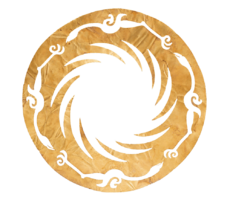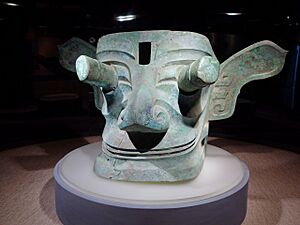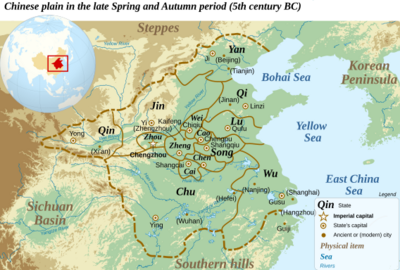Shu (kingdom) facts for kids
Quick facts for kids
Shu
蜀
|
|||||||
|---|---|---|---|---|---|---|---|
| ?–c. 316 BCE | |||||||

Map showing the Kingdom of Shu during Zhou dynasty
|
|||||||
| Government | Monarchy | ||||||
| Historical era | Spring and Autumn period | ||||||
|
• Established
|
? | ||||||
|
• Battle of Muye
|
c. 1046 BCE | ||||||
|
• Conquered by Qin
|
c. 316 BCE | ||||||
|
|||||||
| Shu | |||||||||||||||||||||||||||||||||||
|---|---|---|---|---|---|---|---|---|---|---|---|---|---|---|---|---|---|---|---|---|---|---|---|---|---|---|---|---|---|---|---|---|---|---|---|

"Shu" in seal script (top) and regular (bottom) Chinese characters
|
|||||||||||||||||||||||||||||||||||
| Chinese | 蜀 | ||||||||||||||||||||||||||||||||||
|
|||||||||||||||||||||||||||||||||||
Shu (Chinese: 蜀; Pinyin: Shǔ) was an ancient kingdom in what is now Sichuan Province in China. It was also known as Ancient Shu. This kingdom was located in the western Sichuan basin, mainly around the Chengdu Plain.
Shu had several neighbors. To its east was the Ba tribal confederation. Further east, along the Han and Yangtze rivers, was the powerful State of Chu. To the north, across the Qinling Mountains, lay the State of Qin. The areas to the west and south were home to tribal groups that were not as strong militarily.
The independent kingdom of Shu was eventually conquered by the Qin state in 316 BCE. Recent amazing discoveries by archaeologists at places like Sanxingdui and Jinsha show that a special civilization existed in this area long before Qin took over. Even after Shu was conquered, the Sichuan region continued to be called Shu in Chinese history. Later kingdoms that formed in this same area were also named Shu.
Contents
Discovering the Sanxingdui Culture
Before 316 BCE, the Sichuan Basin was quite separate from the main Bronze Age civilization of China. That civilization was centered in the Yellow River basin to the northeast. The discovery of Sanxingdui in 1987 was a huge surprise. It showed that a major culture existed in Neolithic China that no one knew about before.
Around 2050–1250 BCE, the Sanxingdui site, which is about 40 kilometers north of Chengdu, seems to have been the center of a large kingdom. The objects found in two special pits there are very different from items found further north. Many archaeologists believe this unique culture was that of the ancient Shu kingdom.
The Kingdom of Shu (10th Century BC - 316 BC)
There isn't much information about Shu in early Chinese history books until the 4th century BCE. Some very old writings from the Shang Dynasty might mention Shu, showing they had contact. However, it's not clear if these writings refer to the Shu kingdom in Sichuan or other groups.
Shu is first clearly mentioned in the Shujing, an ancient Chinese text. It says Shu was one of the allies of King Wu of Zhou. These allies helped King Wu defeat the Shang in 1046 BCE at the Battle of Muye. Soon after this victory, another text, Yizhoushu, mentions that one of King Wu's commanders led a military trip against Shu.
After the Battle of Muye, influences from northern China seemed to grow in Shu, then lessen. Shu kept its own distinct culture. Archaeology suggests there was contact with Shu during the late Shang and early Zhou periods. However, there is little proof of strong influence from the later Zhou period. When the Zhou were forced out of the Wei River valley in 771 BCE, Shu likely became even more isolated.
Most written stories about Shu are a mix of myths and legends. These are found in local records and notes, like the Chronicle of the Kings of Shu from the Han Dynasty. Another important text is the Chronicles of Huayang from the Jin Dynasty.
These stories mention several semi-legendary kings. These include Cancong, whose name means "silkworm-bush." He is said to have started silkworm farming in Sichuan. Other kings were Boguan ("cypress-irrigator") and Yufu ("cormorant"). There was also Duyu ("cuckoo").
According to Chronicles of Huayang, Cancong was the first legendary king and had unusual, sticking-out eyes. Duyu is said to have taught the people how to farm. Legend says he turned into a cuckoo bird after he died.
In 666 BCE, a man from Chu named Bieling ("turtle spirit") founded the Kaiming dynasty. This dynasty ruled Shu for twelve generations until the Qin conquest. A legend says Bieling died in Chu, and his body floated upriver to Shu, where he came back to life. In Shu, he successfully managed a big flood. Because of this, King Duyu gave up his throne to Bieling. Another story says the Kaiming kings first lived in the far south of Shu. Then they traveled up the Min River and took over from Duyu.
Ba–Shu Culture: A Blend of Traditions
As the state of Chu expanded west along the Han and Yangtze rivers, it pushed the Ba peoples closer to Shu. In the 5th and 4th centuries BCE, archaeologists believe this interaction helped create the unique Ba–Shu culture in Sichuan. The Shu state also felt some influence from the Chu state.
In 474 BCE, representatives from Shu brought gifts to the Qin state. This was the first time these two states were recorded as having contact. Later, Shu troops crossed the Qinling Mountains and got close to Qin's capital, Yong. In 387 BCE, Shu and Qin armies fought near Hanzhong on the upper Han river.
Shu Under Qin and Han Rule
Qin Conquers Shu in 316 BCE
Around 356–338 BCE, a man named Shang Yang made the Qin state much stronger by making its government more centralized. In 337 BCE, Shu representatives congratulated King Huiwen of Qin when he became king. Around this time, the Stone Cattle Road was built. This road went over the mountains to connect Qin and Shu.
Around 316 BCE, the Marquis of Zu, who controlled part of the Stone Cattle Road, got into a fight with his brother, the twelfth Kaiming King of Shu. The Marquis was defeated and ran away to Ba, and then to Qin. Zhang Yi, a Qin advisor, suggested that Qin should ignore these "barbarians" and keep expanding east into the central plains.
However, Sima Cuo, another advisor, suggested that Qin should use its strong army to take over Shu. He argued that developing Shu's resources would make Qin even stronger for later attacks to the east. Sima Cuo's idea was accepted. Both advisors were sent south as generals. The two armies met near Jaimeng, in Ba territory. The Kaiming king lost several battles and retreated south to Wuyang, where he was captured and killed. Qin then turned on its allies and took over Ba as well.
How Qin and Han Ruled Shu
In 314 BCE, the son of the last Kaiming king was made Marquis Yaotong of Shu. He was meant to rule alongside a Qin governor. But in 311 BCE, an official named Chen Zhuang rebelled and killed Yaotong. Sima Cuo and Zhang Yi invaded Sichuan again and killed Chen Zhuang. Another Kaiming family member, named Hui, was made Marquis. In 301 BCE, he was involved in a plot and chose to take his own life when Sima Cuo's army arrived. His son, Wan, was the last Kaiming marquis. He ruled from 300 to 285 BCE, when he was put to death.
The conquest of Shu more than doubled Qin's land. It gave Qin an area that was safe from other states, except Chu. However, the land needed to be developed before its taxes could be used to make the army stronger. Shu was made a "jun," or commandery, which was a new type of administration. Chengdu was surrounded by a huge wall. Land was divided into rectangular plots and given to new owners. Tens of thousands of settlers were brought in from the north. Many were prisoners or people who had lost their homes in wars further north. They were marched south in groups, watched by Qin officials. The amazing Dujiangyan Irrigation System was started. This system diverted the Min River east to water the Chengdu Plain. Qin's involvement in Ba was less intense. This was probably to avoid upsetting a warlike people living near the border of Chu.
During the conquest of Shu, Chu was busy in the east, taking over Yue. In 312 BCE, Qin and Chu armies fought on the upper Han River. Zhang Yi used threats and tricks to stop Chu from interfering. Later, a Chu general named Zhuang Qiao pushed west. He took over tribal land south of the Yangtze, below Shu. In 281 BCE, Sima Cuo crossed the Yangtze and cut him off from Chu. Zhuang Qiao then declared himself an independent king. He and his soldiers slowly became part of the local population. Starting around 280 BCE, General Bai Qi moved down the Han River and captured the Chu capital in 278 BCE. In 277 BCE, the Three Gorges area was taken. This created a new Qin border east of Sichuan.
Sichuan remained peaceful during the wars before and after the Qin dynasty. This shows that Qin's plan to make the people part of their empire was successful. Archaeological finds in Shu from this time look very similar to those from northern China. However, the Ba area remained a bit different. When Liu Bang started his campaign to create the Han dynasty, Sichuan was a very important place for supplies.
In 135 BCE, under the expanding Emperor Wu of Han, General Tang Meng tried to reach the Kingdom of Nanyue by going south of the Yangtze River. A little later, Sima Xiangru pushed into the hilly area west of Sichuan. These military trips into tribal lands cost more than they were worth. In 126 BCE, both campaigns were stopped to move resources to the Xiongnu wars in the north. In the same year, Zhang Qian returned from the west. He reported that it might be possible to reach India from Sichuan. An attempt to do this was blocked by the hill tribes. In 112 BCE, Tang Meng started his expansion wars southward again. His harsh methods almost caused a rebellion in Sichuan. Sima Xiangru was brought in to make policies more gentle. By this time, Chinese expansion across flat farming land had reached a natural limit. Expanding into the hilly country to the south and west was much slower.
Shu in Astronomy
The star Alpha Serpentis represents Shu in the group of stars called Right Wall. This is part of the Heavenly Market enclosure in Chinese constellations. The star Lambda Serpentis is also included in this group in some old star maps.
See also
- Clothing in ancient Shu
- Jinsha
- Sanxingdui
- Shu embroidery
- Second Kingdom of Shu
- Third Kingdom of Shu
- Fourth Kingdom of Shu
- Tombs of boat-shaped coffins





